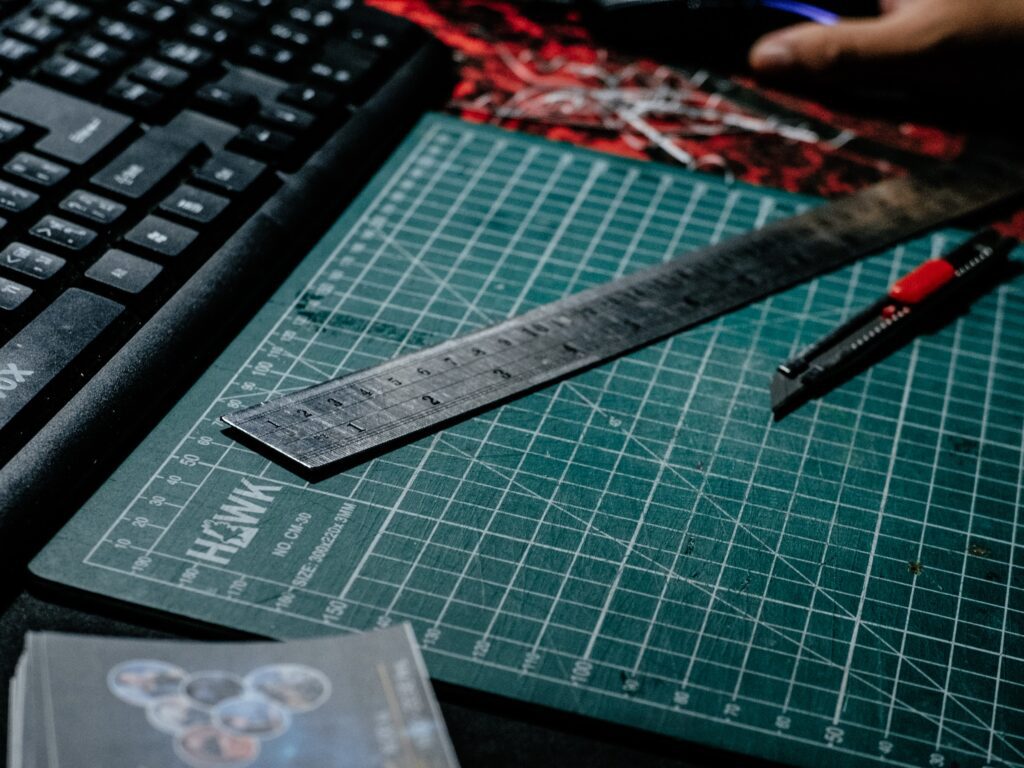Ready to learn the secrets of keeping your tubing cutter sharp and effective? Look no further! In this article, we will guide you through the necessary steps to maintain your cutter, ensuring it stays in top-notch condition. Whether you’re a professional plumber or a DIY enthusiast, these tips and tricks will save you time and money, while guaranteeing precise cuts every time. Don’t let a dull cutter slow you down – let’s get started on keeping your tubing cutter at its best!



This image is property of images.unsplash.com.
Understanding Tubing Cutters
What is a Tubing Cutter
A tubing cutter is a tool specifically designed for cutting various sizes and types of tubing materials. It typically consists of a cutting blade, a handle for grip, and a mechanism for adjusting the cutting diameter. Tubing cutters are commonly used in plumbing, automotive, HVAC, and other industries where precise and clean cuts are essential.
Types of Tubing Cutters
There are several types of tubing cutters available on the market, each designed for specific applications and materials. Some common types include:
-
Standard Tubing Cutter: This type of cutter is the most basic and versatile, capable of cutting copper, aluminum, and plastic tubing. It usually features a rotating cutting wheel that scores the surface of the tubing, creating a clean, controlled cut.
-
Mini Tubing Cutter: As the name suggests, this smaller-sized cutter is designed for cutting smaller diameter tubing, usually up to 1/2 inch. It is commonly used in tight spaces where a standard cutter may not fit.
-
Close Quarters Tubing Cutter: This specialized cutter is ideal for confined areas and tight spaces where standard cutters may be challenging to maneuver. It often features a compact design and a ratcheting mechanism for ease of use.
-
Ratcheting Tubing Cutter: Unlike standard cutters, ratcheting tubing cutters provide increased cutting power and leverage. They are particularly useful when cutting through thicker or harder materials.
Applications of Tubing Cutters
Tubing cutters find extensive applications in various industries and sectors. Some common uses include:
-
Plumbing: Tubing cutters are essential tools for plumbers, used for cutting copper, PVC, and plastic pipes for plumbing installations and repairs.
-
Automotive: In the automotive industry, tubing cutters are used for cutting brake lines, fuel lines, and other tubing used in vehicles.
-
HVAC: HVAC technicians utilize tubing cutters to cut refrigerant lines, ductwork, and other tubing systems in heating, ventilation, and air conditioning installations.
-
DIY Projects: Tubing cutters are popular among DIY enthusiasts for a wide range of projects involving tubing materials, such as irrigation systems or home improvement tasks.
Importance of Maintenance
Ensuring Longevity
Proper maintenance of tubing cutters is essential to ensure their longevity. Regular cleaning, lubrication, and sharpening of the blades help prevent wear and tear, extending the tool’s lifespan. With routine maintenance, tubing cutters can provide reliable and consistent performance for a more extended period.
Sustaining Performance
Regular maintenance also plays a vital role in sustaining the performance of tubing cutters. Blades that are kept sharp and in excellent condition ensure clean and precise cuts, reducing the chances of errors and minimizing the need for rework. Well-maintained cutters operate smoothly, resulting in improved efficiency and productivity.
Reducing Operational Costs
Investing time and effort into maintaining tubing cutters can significantly reduce operational costs in the long run. By keeping the blades sharp and properly aligned, the cutter requires less force to make cuts, reducing strain on the tool and decreasing the risk of premature blade failure. This, in turn, helps minimize the need for frequent blade replacements and costly repairs.



This image is property of images.unsplash.com.
Inspection of Tubing Cutters
Identifying Dull or Damaged Blades
Regular inspections of tubing cutters are crucial to identify any signs of dull or damaged blades. Dull blades can lead to jagged or imprecise cuts, while damaged blades may cause difficulty in cutting or even pose safety hazards. During inspections, carefully examine the cutting edge and look for signs of wear, nicks, or chips. If any damage is detected, it is essential to promptly address and repair or replace the blades as needed.
Checking Alignment of Parts
Proper alignment of the cutting wheel and other parts is vital for ensuring the cutter’s performance. Misalignment can result in uneven cuts or even damage to the tubing. Inspect the cutting wheel, blade, and other components for any signs of misalignment, and make necessary adjustments if required.
Spotting Rust or Corrosion
Rust or corrosion can affect the functionality and structural integrity of tubing cutters. Regularly inspect the entire tool, paying close attention to areas prone to rust, such as the cutting blade and handle. If rust or corrosion is detected, clean the affected area and apply an appropriate rust inhibitor to prevent further damage.
Cleaning Tubing Cutters
Choosing the Right Cleaning Solutions
Selecting the right cleaning solutions is crucial to maintain the performance and condition of tubing cutters. Avoid using harsh chemicals or abrasive cleaners that may potentially damage the tool’s surfaces or components. Instead, opt for mild, non-corrosive cleaners that effectively remove dirt, debris, and light residues without causing harm.
Using Proper Cleaning Techniques
When cleaning tubing cutters, it is essential to follow proper techniques to ensure thorough cleaning and prevent any damage. Disassemble the cutter as per the manufacturer’s instructions, and clean each part separately. Use a soft brush or cloth to remove any dirt or debris, paying close attention to hard-to-reach areas. Rinse the parts with clean water and allow them to dry completely before reassembling the tool.
Post-Cleaning Inspections
After cleaning, perform a post-cleaning inspection to make sure all parts are clean, free of debris, and in good condition. Check the cutting blade for any remaining residue or buildup that may affect its performance. Additionally, inspect the handle and other components for any signs of damage or wear. If any issues are identified during the inspection, address them promptly before using the cutter again.



This image is property of images.unsplash.com.
Sharpening Tubing Cutters
Knowing When to Sharpen
Regular blade sharpening is necessary to maintain the cutting performance of tubing cutters. Signs that indicate the need for sharpening include difficulty in making clean cuts, increased force required to cut through tubing, or noticeable dullness on the cutting edge. It is important to sharpen the blades before they become excessively dull or damaged to ensure optimal cutting efficiency.
Choosing a Sharpening Tool
Selecting the right sharpening tool is crucial for achieving proper sharpening results. Manual sharpening stones or honing devices specifically designed for tubing cutter blades are commonly used. Ensure that the chosen tool matches the blade material and provides the appropriate level of abrasiveness for sharpening.
Effective Sharpening Techniques
When sharpening tubing cutter blades, it is important to follow effective techniques that yield the best results. Start by removing any surface rust or debris from the blade. Hold the sharpening tool at the correct angle, typically around 45 degrees, and stroke the blade across the sharpening surface in a smooth and consistent motion. Repeat the process several times, alternating sides of the blade, until the desired sharpness is achieved.
Replacing Tubing Cutter Blades
Recognizing When Replacement Is Required
Despite regular maintenance and sharpening, there may come a time when tubing cutter blades need to be replaced. Signs that indicate blade replacement is necessary include severe damage, excessive wear, or inability to achieve a sharp cutting edge even after sharpening. If the blade becomes too thin or significantly chipped, it is best to replace it rather than risk compromising the cutter’s performance and safety.
Choosing the Right Replacement Blade
When selecting replacement blades for tubing cutters, it is crucial to choose the correct size and type. Blades come in various sizes to fit different tubing cutter models, so refer to the manufacturer’s recommendations to ensure compatibility. Additionally, consider the specific material and thickness of the tubing being cut to choose a blade with the appropriate cutting edge design and durability.
Guidelines for Safe and Effective Blade Replacement
Properly replacing tubing cutter blades is essential for both safety and performance. Follow these guidelines for safe and effective blade replacement:
- Always disconnect the cutter from any power source or turn off any mechanisms before replacing the blades.
- Refer to the manufacturer’s instructions for specific steps on how to safely remove and replace blades.
- Use caution when handling sharp blades and wear appropriate protective gloves.
- Ensure that the replacement blade is securely fastened and properly aligned before using the cutter again.
Lubricating Tubing Cutters
Understanding the Importance of Lubrication
Lubricating tubing cutters is essential for maintaining smooth operation and preventing premature wear. Proper lubrication reduces friction between moving parts, minimizing heat and stress on the tool. It also helps to prevent rust or corrosion, especially in humid or corrosive environments.
Choosing the Right Lubricant
Selecting the appropriate lubricant is crucial for effective lubrication of tubing cutters. Silicone-based lubricants are commonly recommended as they provide excellent lubrication properties without attracting dust or debris. Avoid using petroleum-based products or thick, heavy greases that may gum up the tool or cause clogging.
Applying Lubricant Properly
When applying lubricant to tubing cutters, it is important to follow proper application techniques. Disassemble the cutter as per the manufacturer’s instructions to access the moving parts. Apply a small amount of lubricant to the pivot points, the cutting wheel, and other moving components. Use a cloth or brush to distribute the lubricant evenly and remove any excess. Reassemble the cutter and operate it a few times to ensure smooth movement and proper lubrication distribution.
Storing Tubing Cutters
Selecting a Suitable Storage Location
Proper storage of tubing cutters is crucial for maintaining their performance and longevity. Choose a suitable storage location that is dry, clean, and well-ventilated. Avoid storing the cutter in areas prone to extreme temperatures, moisture, or direct sunlight, as these conditions may cause damage or deterioration.
Protecting Cutters from Moisture and Dust
Moisture and dust can negatively impact the functionality of tubing cutters, causing rust, corrosion, or clogging. To protect the tool, store it in a sealed container or a dedicated toolbox with moisture-absorbing packets or silica gel packs. Prior to storage, make sure the cutter is completely dry by wiping it down with a clean, dry cloth.
Ensuring Cutters are Clean and Dry Before Storage
Before storing tubing cutters, it is crucial to ensure that they are clean and dry to prevent any potential damage. Thoroughly clean the blades and other components, removing any debris or residue. Check for any signs of moisture and ensure the tool is completely dry before placing it in storage. This helps prevent the growth of mold or rust during extended periods of storage.
Common Troubleshooting Tips
Addressing Common Issues with Tubing Cutters
Tubing cutters may encounter common issues that can affect their performance. Some of these issues include:
-
Difficulties in Cutting: If the tubing cutter is struggling to make clean cuts, check for dull blades, misalignment, or debris in the cutting area.
-
Blade Slippage or Inconsistency: If the blade slips or cuts inconsistently, it may be due to loose or worn parts. Inspect the cutter for any loose screws or components that need tightening or replacement.
-
Blade Jamming: Blade jamming can occur if the cutter is used to cut tubing beyond its specified capacity. Avoid forcing the cutter and ensure you are using the appropriate cutter for the tubing size and material.
Implementing DIY Fixes
For minor issues with tubing cutters, there are several DIY fixes that can be attempted before seeking professional help. Some common DIY fixes include:
-
Cleaning and Lubricating: Cleaning and lubricating the tool can often resolve minor issues, such as sticky operation or difficulty in cutting.
-
Alignment Adjustments: If the cutter is not making precise cuts, adjusting the alignment of the cutting wheel and other components may help improve performance.
-
Blade Sharpening: Dull blades can often be sharpened to restore cutting efficiency. Refer to the sharpening techniques mentioned earlier for guidance.
Knowing When to Seek Professional Help
While many issues with tubing cutters can be resolved through DIY fixes, there may be instances when professional help is necessary. Seek professional assistance if:
-
Structural Damage: If the cutter has suffered severe damage, such as bent or broken parts, it is best to have it assessed and repaired by a professional.
-
Complex Issues: If the problem persists despite DIY fixes or is beyond your level of expertise, it is advisable to consult a professional for proper diagnosis and repair.
Safe Use and Maintenance Practices
Operating Tubing Cutters Safely
Maintaining safety while using tubing cutters is of utmost importance. Follow these safety practices:
-
Protective Gear: Wear appropriate protective gear, including safety glasses and gloves, to protect against potential injury.
-
Secure Workpiece: Ensure that the tubing being cut is properly secured in place before applying force with the cutter.
-
Proper Grip: Maintain a firm grip on the handle of the cutter to prevent slipping or loss of control.
-
Apply Steady Pressure: Apply steady and even pressure while cutting, avoiding excessive force that may damage the cutter or cause accidents.
Adhering to Regular Maintenance Routine
Establishing a regular maintenance routine for tubing cutters helps ensure optimal performance and longevity. Set a schedule for cleaning, lubricating, and inspecting the cutter, and be consistent in performing these tasks. Regularly sharpen blades as needed to maintain cutting efficiency and reliability.
Training for Proper Use and Maintenance
Proper training is crucial to ensure safe and effective use and maintenance of tubing cutters. Train operators and maintenance personnel on the correct operation techniques, safety precautions, and maintenance procedures specific to the cutter models being used. Providing comprehensive training helps prevent accidents, maximizes productivity, and extends the lifespan of the tools.
By understanding the various aspects of tubing cutters, including their types, applications, and maintenance processes, users can effectively keep these tools sharp and effective. Following proper maintenance practices, conducting regular inspections, and addressing issues promptly will ensure that tubing cutters remain reliable and deliver excellent results for a long time. Remember, safety should always be a top priority, so observe safe operating practices and provide adequate training for all individuals working with tubing cutters.
